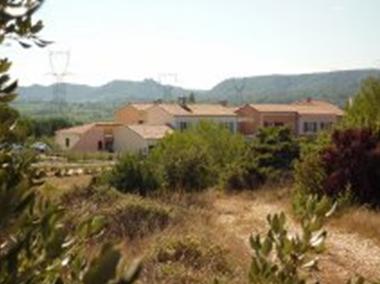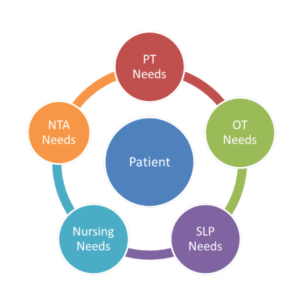Skilled care in the south of France
Even after 20 years of running nursing facilities in Texas, my interest in learning more about geriatric healthcare continues. In late 2012, I had the opportunity, while in southern France, to visit a maison de retraite medicalisee, otherwise known as a nursing home.
A VILLAGE WITHIN A VILLAGE
The Maison de Retraite Augusta Besson is a relatively new nursing home built in the outskirts of Saint Paul Les Fonts, a quaint French village, on grounds donated by the city council. The village population is around 800 residents. Besson is associated with a nearby hospital in Pont Saint Esprit.
 C. Albe, a close relative, is a retired psychologist, who volunteers at Besson because it currently does not have a staff psychologist. He introduced me to Annick Grisolet, the facility administrator. Grisolet said, “Besson is like a village. Residents’ rooms are their homes; hallways are the streets; offices, kitchen and living areas are public places where people meet, walk by, stop to talk, go to work.
C. Albe, a close relative, is a retired psychologist, who volunteers at Besson because it currently does not have a staff psychologist. He introduced me to Annick Grisolet, the facility administrator. Grisolet said, “Besson is like a village. Residents’ rooms are their homes; hallways are the streets; offices, kitchen and living areas are public places where people meet, walk by, stop to talk, go to work.
“Also there are neighborhoods where residents congregate, rest on a bench, watch life pass by, sit under a tree or talk to their neighbors from the door of their ‘homes.’ However, this village shelters elderly from Saint Paul Les Fonts and neighboring communities ‘to preserve the residents’ family and social support network.”
THE MAISON DE RETRAITE
Augusta Besson is a three-story facility: The lower level houses the kitchen, maintenance, storage areas and the garage; the first floor includes administration, the lobby with its fireplace and exotic fish aquarium, an activity/therapeutic kitchen, medical offices and resident rooms. A diner for dependent residents, additional resident rooms and a therapeutic room are located on the second floor.
Each of the 60 resident rooms includes a shower with nonskid tiles, a toilet, a sink with controlled hot and cold water and a shower chair that fits easily on the toilet. All resident rooms have a wall TV set, a phone and an electric ceiling lift device for bed to wheelchair transfer.
Three dining rooms cater to residents’ needs from total assistance to independent residents. The kitchen boasts four large walk-in freezers to meet not only state but also European food-storage regulations. The dietary supervisor is state licensed and euro-licensed as well. In addition to providing resident meals, the facility also provides lunch to children from a nearby school, promoting intergenerational communication.
RESIDENT PROFILE
Most of the Augusta Besson’s elderly residents are age 60 and older, some needing intensive care, which is why the facility is labeled “medicalisee,” making it more of a nursing home rather than a retirement center. Facility personnel include a physician, nursing and rehabilitation staff, a dietary staff, an activities director, a part-time social worker and psychologist, maintenance and laundry staff and, of course, the administrator.
There are 41 “permanent,” or long-term beds, 14 beds are available in a locked Alzheimer’s unit that opens into an enclosed Mediterranean garden, and there are five short-term, or “temporary,” or “day-care” beds.
In the French healthcare system, the AGGIR* measures a resident’s dependency level of assistance, comparable to our Minimum Data Set (MDS) system. There are six AGGIR groups ranging from least to total dependency. At the resident’s admission, activities of daily living are assessed to determine the individual’s levels of independence in 10 areas that include cognition, orientation, toileting, clothing, eating, hygiene, transfer, ambulation inside/outside the building, distance communication (phone/email).
A COMPLEX PAYMENT SYSTEM
According to the administrator, the daily rate varies from one facility to another; it is fixed at the department** level, yet cannot exceed the national daily rate. It incorporates three cost elements: resident care, dependency level and living accommodations. The cost to a resident is based on the dependency level and living accommodations, as the resident care cost is paid for by the French equivalent of Social Security.
Those residents assigned GIR 1–4 (the higher levels of care) can be partially compensated by APA, a public fund allowance determined by the departement. GIR 5 and GIR 6 costs vary according to the resident’s resources.
Physician’s visits and expenses are the resident’s responsibilities. This GIR rate is defined yearly by physicians from the Conseil General (legislative body of the departement) and the Regional Health Agency. Living accommodations costs fluctuate from one facility to another and from one departement to another. Government assistance is provided to those residents unable to pay the living accommodations rate, which averages 45 euros a day. The facility can legally require the resident’s family to contribute financially to any or all costs.
Additional financial aid may be available to the resident from other sources. At Augusta Besson, the daily rate for living accommodations is between 54.23 euros and 60 euros.
The average monthly rate (exclusive of “resident care” rate paid by the French social security agency) at Augusta Bessom runs between 2,500 euros–2,000 euros for GIRs 5 and 6) because it is located in a rural area. In an urban environment, the average rate is 3,000 euros; in some instances, however, the rate may exceed 5,000 euros.
ACCOUNTABILITY
In 2013, Augusta Bessom will be evaluated by residents and families and it will make care adjustments where needed. The facility is scheduled to be surveyed by the Regional Health Agency, the Conseil General and veterinary services (for infection control) in 2014. Representatives from the Haute Autorite de Sante*** have to certify the nursing home every 4 years to ensure the facility’s implementation and maintenance of quality of care, resident safety and cost control.
 Augusta Besson consistently has been a top-of-the-line nursing facility since its completion a few years ago. However, as the baby boomers reach retirement, the financial pressure on facilities like Augusta Besson will grow. Will future residents in 2020 be able to expect the kind of living accommodations and quality care provided today by Augusta Besson? That’s the “3,000 euro” question.
Augusta Besson consistently has been a top-of-the-line nursing facility since its completion a few years ago. However, as the baby boomers reach retirement, the financial pressure on facilities like Augusta Besson will grow. Will future residents in 2020 be able to expect the kind of living accommodations and quality care provided today by Augusta Besson? That’s the “3,000 euro” question.
LESSONS LEARNED
Admission procedures in the United States look easy compared to the ones in France and yet one complains about the “paperwork.” Special attention to the Dietary Department: the space provided for food conservation (four walk-in freezers), food preparation and staff certification requirements: we walked in unannounced and could have eaten on the kitchen floor. Patients have access to common and private amenities one would find only in private-pay facilities in the USA. However, as stated in my conclusion, how long is this system financially sustainable?
FINAL THOUGHTS
French long-term care is a complex system involving European, national and local healthcare agencies. My relative was unaware of all the steps needed before admission to such a facility. The new socialist administration plans to simplify the admission and reimbursement systems in the coming years.
Gabriel Bach, PhD, MBA, is a professor at North Lake College in Irving, Texas. He has more than 17 years of experience in Health Services Management and was runner-up for the Texas Health Care Association’s 2001 Texas Administrator of the Year. Send email to Gabriel_bach@hotmail.com.
FOOTNOTES
*Autonomie Gerontologie Groupes Iso-Ressource, which is equivalent to the Minimum Data Set (MDS) in the United States.
**Departement is a territorial administrative unit comparable to a U.S. state, but with less autonomy.
***Haute Autorite de Sante is the French National Authority for Health (08/13/2004 Law on Social Security).
I Advance Senior Care is the industry-leading source for practical, in-depth, business-building, and resident care information for owners, executives, administrators, and directors of nursing at assisted living communities, skilled nursing facilities, post-acute facilities, and continuing care retirement communities. The I Advance Senior Care editorial team and industry experts provide market analysis, strategic direction, policy commentary, clinical best-practices, business management, and technology breakthroughs.
I Advance Senior Care is part of the Institute for the Advancement of Senior Care and published by Plain-English Health Care.
Related Articles
Topics: Alzheimer's/Dementia , Articles , Clinical , MDS/RAI , Medicare/Medicaid , Regulatory Compliance











